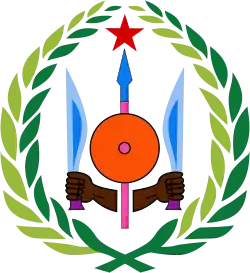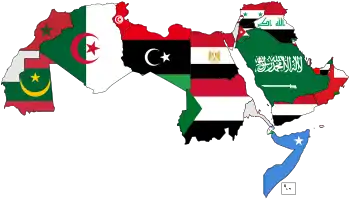Flag of Djibouti
The national flag of Djibouti (Somali: Calanka Jabuuti, Arabic: علم جيبوتي Alm Jibuti, French: Drapeau de Djibouti) is a horizontal flag bicolor with equal bands of light blue and light green, with a white, equilateral triangle at the hoist. In the center of the triangle is a red star.[1] The flag combines the basic layout and colors from the flag of the Front de Libération de la Côte des Somalis. The light blue represents the sky and the sea, as well as the Issa Somalis, green represents the everlasting green of the earth, as well as the Afars, white represents the colour of peace and the red star represents the unity and the blood shed by the martyrs of independence.
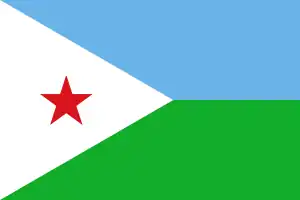 | |
| Name | Drapeau National علم الوطني Alm al-Watani ("National Flag") |
|---|---|
| Use | National flag and ensign |
| Proportion | 2:3 |
| Adopted | June 27, 1977 |
| Design | A horizontal bicolour of light blue and light green, with a white isosceles triangle at the hoist bearing a red star in its center. |
History
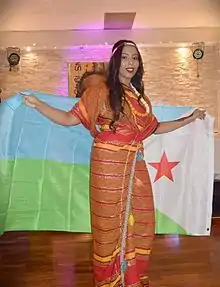
Before the establishment of the French territory in Arabia, the flag of the Sultanate of Tajoura was the only ensign used in the territory.[2] The flag of Djibouti was later created in 1970. Adopted in 1977, the national flag was an adaptation of the flag of the Front for the Liberation of the Somali Coast (FLCS), a guerrilla group that led Djibouti with the Ligue Populaire Africaine pour l'Independence (LPAI) to independence.[2] The flag of Djibouti was raised for the first time upon independence on 27 June 1977,[2] by the head of police Yacine Yabeh Galab. It is today flown on many governmental buildings.
Characteristics
The flag of Djibouti features two equal horizontal bands of blue (top) and green, with a white isosceles triangle based on the hoist side. The triangle bears a red star in its centre, which represents unity and blood. Each colour symbolizes something different; namely, the earth (green), the sea and sky (light blue), peace (white), and unity (red).[2] The light blue represents the Sky, and the green represents the everlasting green of the earth. The red star stands for unity and the bloodshed of martyrs.[1]
Color
(1977–present) |
Light Blue | Green | Red | White |
|---|---|---|---|---|
| Pantone | 284c | 354c | 185c | White |
| CMYK | 59-11-0-0 | 77-0-100-0 | 0-86-63-0 | 0-0-0-0 |
| RGB | 106-178-231 | 18-173-43 | 239-51-64 | 255-255-255 |
| Hexadecimal | #6AB2E7 | #12AD2B | #D7141A | #FFFFFF |
Historical flags
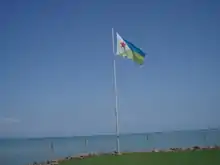
The following are the flags historically used in the territory of present-day Djibouti:
 Flag of the Adal Sultanate (1415–1577)
Flag of the Adal Sultanate (1415–1577).svg.png.webp) Flag of the Ottoman Empire, used when Habesh Eyalet included part of present-day Djibouti.
Flag of the Ottoman Empire, used when Habesh Eyalet included part of present-day Djibouti. Flag of France, used between 1896 and 1977, as French Somaliland is the predecessor to today's Djibouti.
Flag of France, used between 1896 and 1977, as French Somaliland is the predecessor to today's Djibouti.
References
- Anjali Kamath. Flag Book. Popular Prakashan. p. 19. ISBN 978-81-7991-512-7.
- "flag of Djibouti". Encyclopædia Britannica. Retrieved 15 September 2014.
